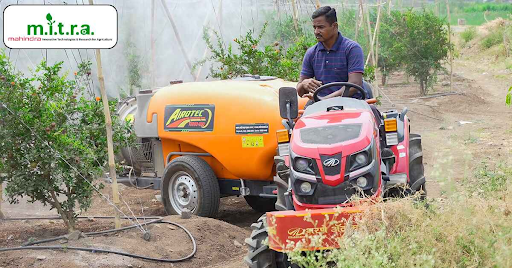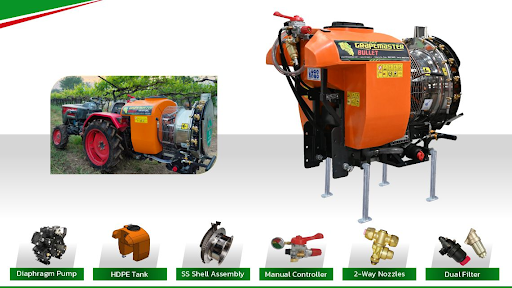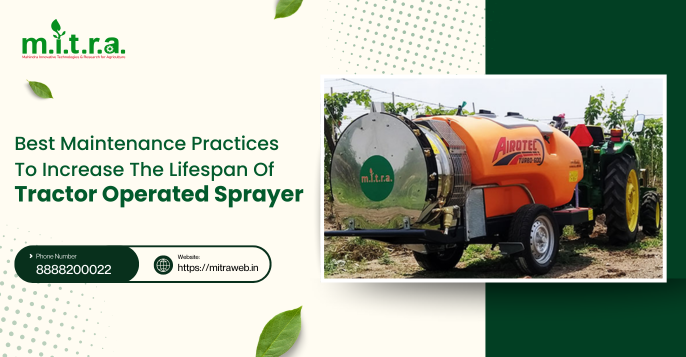Have you ever stopped mid-spraying only to find a leak, clogged nozzle, or a pump failure? For farmers relying on tractor operated sprayer systems in India’s demanding fields, such downtimes translate to lost time, wasted chemicals, and frustration. But what if simple care routines could extend the life of your sprayer by years and save you thousands in repair costs? In this post, we’ll walk you through the best maintenance practices — from daily cleaning to seasonal storage — to keep your tractor operated power sprayer operating reliably. Along the way, you’ll also see how MITRA’s designs make maintenance easier, and what to look for when choosing the best tractor operated sprayer.

1. Why Lifespan & Maintenance Matter
- Cost & ROI: A well-maintained sprayer can last 8–10+ years, while neglect can shorten life to half.
- Efficiency & Accuracy: Poor maintenance leads to uneven sprays, chemical waste, and crop damage.
- Reduced Downtime: Especially during peak spray season, breakdowns cost precious hours.
- Sustainability & Safety: A leaky or malfunctioning sprayer can contaminate soil or harm operators.
According to Pentair, the performance of sprayers degrades if nozzles are worn by even 10%, you lose accuracy and increase chemical usage.

2. Key Maintenance Practices
Below are systematic recommendations you can follow.
2.1 Cleaning & Flushing (Every Use)
- Empty the tank fully after spraying. Do not let the chemical linger.
- Rinse & flush the system: fill with clean water (or recommended neutralising solution), run the sprayer for a few minutes to flush hoses, pump, and nozzles. (Source: Patel Agro)
- Remove and clean nozzles, strainers, and filters—soak them in mild soap, avoid using sharp metal pins that can enlarge or damage the orifice.(Source: Aspee)
- Triple rinse if switching chemicals to avoid cross-contamination. (MITRA also suggests this in their blog)
2.2 Inspection & Leak Checks (Daily / Weekly)
- Inspect hoses, joints, clamps, seals, and O-rings for cracks, wear or leaks.
- Check tank body for cracks or weld damage.
- Ensure all fasteners (bolts, nuts) are tight but not over-torqued.
- For sprayers with pumps: ensure pump casing is intact, and check for signs of cavitation or abnormal vibration.
2.3 Nozzle, Filter & Hose Care
- Test each nozzle’s spray pattern (spray a test strip) to ensure uniform distribution. Replace or clean clogged or misbehaving nozzles.
- Clean or replace inline filters, suction filters, and line strainers regularly.
- For hoses, avoid sharp bends, kinks, or dragging them on the ground; periodically pressure test them.
- Keep a set of spare nozzles, gaskets, and O-rings on hand, especially during the busy season. MITRA explicitly advises keeping spare parts.
2.4 Calibration & Pressure Checks
- Proper calibration ensures you are applying the correct dosage per hectare.
- Check pressure gauges, flow rates, and spacing.
- Confirm that spray width and boom height are appropriate for the crop and nozzle configuration.
- Recalibrate if you change nozzles, pressure, or spray speed.
2.5 Lubrication & Moving Parts
- Grease or oil moving joints, linkages, pivot pins, bearings per manufacturer’s schedule.
- Check PTO shaft, universal joints, and couplings. Ensure shield and guards are in place.
- For diaphragm or piston pumps, check internal seals, replace them if worn, and maintain correct oil levels (if applicable).
2.6 Proper Storage & Off-Season Care
- After the final use of the season, deep clean all components. Use neutralising agents if chemical build-up is stubborn.
- Drain all fluid from the system—hoses, pump, nozzles, tank.
- Let all parts dry thoroughly to prevent rust or microbial growth.
- Store sprayer under shelter (shed) or cover with tarpaulin—avoid direct sun or rain exposure.
- Loosen tension on belts, relieve any pressure on springs or mechanical assemblies.
- Periodically rotate or operate the system (with water) in off season to prevent seizing.
2.7 Replacement of Worn Parts
- Nozzles with >10% wear should be replaced.
- Replace worn seals, gaskets, and O-rings before they fail and cause leaks.
- Replace hoses that show signs of aging, internal delamination, cracks or bulging.
Maintain a log of hours of operation or spray cycles to anticipate parts overhaul.
3. Product-Level Suggestions & What to Look For
When choosing a tractor operated sprayer (or tractor operated power sprayer), these design features help reduce maintenance burden and extend life:
- Pressure relief valves (PRV) to prevent overloading the pump.
- Backwash or self-cleaning filters simplify maintenance.
- Easy access to nozzles, filters, and pump for quick servicing.
- Use of HDPE or corrosion-resistant tanks and stainless or brass wetted components.
- Modular design (interchangeable parts) and wide availability of spares.
- Accurate controllers / automatic monitoring to prevent misuse.
- Durable, strong boom structure with adjustable height (winch or hydraulics).
4. Advanced & Trending Topics in Sprayer Maintenance
- Sensor & IoT-enabled monitoring: Pressure, flow and nozzle sensors can alert users to blockages or leaks.
- Automatic flushing & self-cleaning heads: Some modern sprayers now include automated rinse cycles to reduce manual labour.
- Use of smart spray controllers that adjust pressure or shut off nozzles dynamically to reduce wear.
- Predictive maintenance using usage logs and component life estimation.
- 3D printed or rapid spares: Some OEMs now provide quick replacement parts via 3D printing.
5. Common Mistakes to Avoid
- Skipping cleaning after each use, leading to clogging and residue buildup.
- Using metal wires or pins to unclog nozzles — this can damage orifice geometry.
- Ignoring minor leaks or drips until they worsen.
- Not recalibrating after nozzle or pressure changes.
- Storing sprayers with residual chemicals or moisture inside.
- Overpressurizing pumps beyond rated limits.
- Relying on generic parts rather than genuine OEM spares (especially seals, nozzles).
Avoiding these mistakes can prevent sudden breakdowns in the field.
6. Conclusion
A tractor operated sprayer (or tractor operated power sprayer) is a significant investment for any progressive farmer. But it’s not just about selecting the best machine — daily care, systematic maintenance, and smart product features determine how long it serves you.
Follow the cleaning, inspection, calibration, lubrication, and storage practices above to maximize longevity. And when you evaluate new sprayer options, look for features that reduce maintenance burden and ease servicing. MITRA’s range, Cropmaster, Airotec, and others—offer such thoughtful design plus strong service support in India.
If you’re considering upgrading or adding a sprayer, or want to see which MITRA model fits your crop and tractor, visit MITRA’s official site and request a demo.
